
SEA STAR INTRODUCTION
Welcome to the second edition of SEA STARS OF THE PACIFIC NORTHWEST. This website includes descriptions of over 30 species of sea stars encountered from the intertidal zone to a depth of 30 m (100 ft) on the Pacific coast of North America from northern California, Oregon, Washington State, British Columbia and southeast Alaska.
In the summer of 2013 a huge die-off of sea stars was observed along this entire coast which ultimately lead to the death of millions of sea stars belonging to over 20 different species. It is considered one of the largest mass mortalities of a specific group of animals in recorded history. Researchers have done an admirable job of determining the pathogen in this disease, dubbed the SEA STAR WASTING DISEASE, but the actual causes of the epidemic are still unclear. This updated version includes a page devoted to this important issue.
The scientific names that have been given to our sea stars are not carved in stone. With new genetic sequencing tools and other methods, researchers are now better able to determine the relationships amongst sea stars. Since the original version of the website there have been a few name changes and new species described.
I've been interested in sea stars since 1969 when I started diving while at the University of British Columbia. Near Vancouver I observed many different types of sea stars and found them fascinating. They were diverse, abundant and integral components of bottom communities. I studied the predatory MORNING SUN STAR Solaster dawsoni and made many dives observing its behaviour and that of its prey, which are mostly other sea stars.
The intent of this website is to supplement existing references with additional pictures, field observations and the results of lab studies. Divers, especially those with still and video cameras, are often witnesses to behaviours never seen before and can add invaluable information.
Sea stars are found virtually everywhere in the marine environment. Beach walkers will find the greatest variety along rocky shores at low tide; as many as a dozen species or more. Large tidal pools are especially rich habitats full of colourful marine life. An additional handful can be seen on sandy or muddy substrates in bays, often crawling about in eelgrass beds.
Scuba divers have the advantage of exploring the sea floor below the intertidal zone and encountering many different sea stars. Most live on bedrock or boulder substrates, although a number of species prefer sand or mud habitats. Digital underwater photography offers the ideal way to document sea stars. And underwater video is the perfect tool to record their interesting behaviours.
Most sea stars in the PNW are relatively easy to identify in the field, based on the number, proportion and size of their arms, their colour and the shape of the skeletal plates and spines. A few look-alikes may cause confusion but specific tips are included to help sort these out.
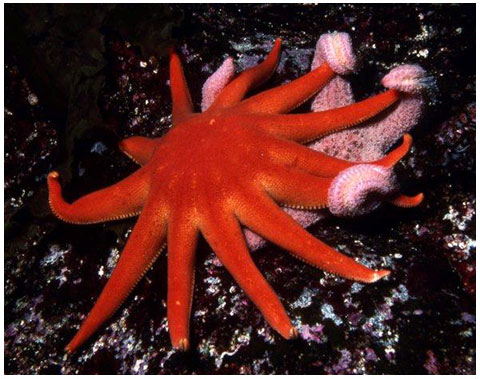
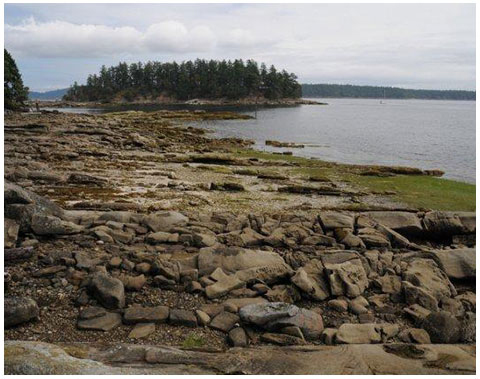
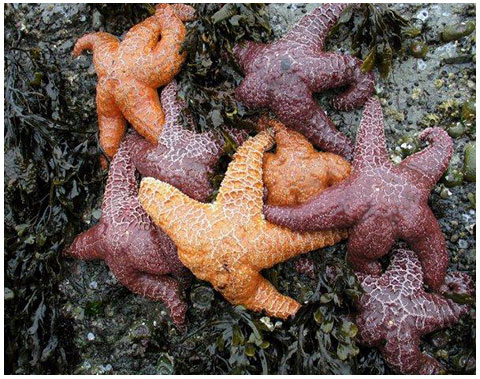
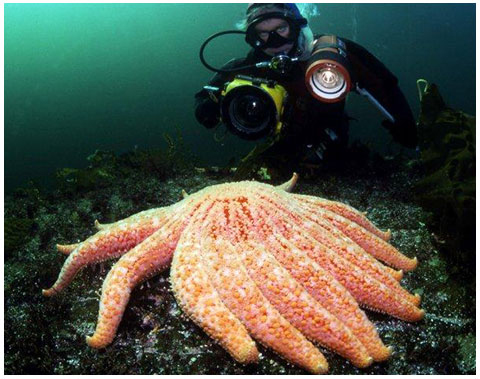
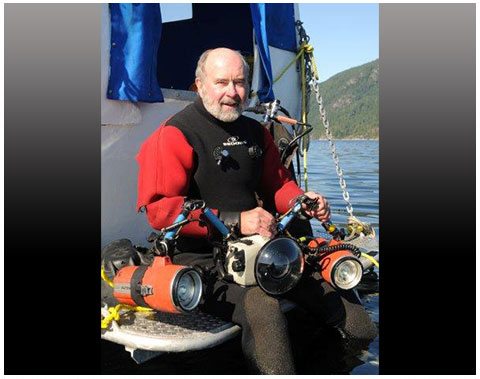
My interest in sea stars was first kindled by the voracious predatory behaviour of the MORNING SUN STAR and the reactions of its prey.
Low tide in the Gulf Islands, BC, the best time for beach walkers to observe sea stars and other fascinating marine creatures.
A group of PURPLE STARS exposed at low tide on the west coast of Vancouver Island. These stars are well adapted to intertidal life and are able to keep cool and moist even on hot summer days. Cathryn McDaniel photo.
Underwater photographer Mark Atherton lines up on a hefty SUNFLOWER STAR, one of the world's largest sea stars. Monsters like this are now rare due to the ravages of Sea Star Wasting Disease.
Many of the pictures on this site were taken with a Nikon D100 digital SLR in a Subal housing, along with my Ikelite 150 strobes. Geoff Grognet photo.
5 - 5
Previous
NEXT
Your Comments & Questions Are Welcome
INTRODUCTION | ABOUT SEA STARS | BIOLOGY | SPECIES | PREDATORS / PREY | SEA STAR WASTING DISEASE | ACKNOWLEDGEMENTS | FIELD GUIDE | VIDEO
Copyright © 2018 All rights reserved.
